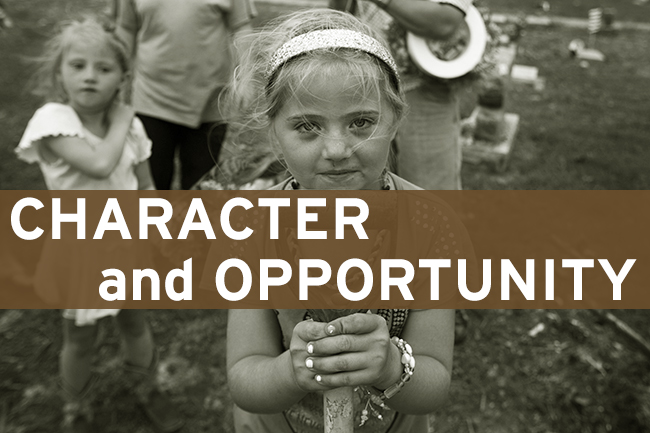In this essay from the Center on Children and Families’ Essay Series on Character and Opportunity, Marc Dunkelman says the sociological implications of character have been left broadly unexamined, but predicts that soon we will develop a clearer view of how grit ripplesout from the individual to the interpersonal and from social architecture to societal fortune.
As more research emerges on the roots and substance of “character,” the public policy implications are coming into clearer view. The interplay between what Richard Reeves has termed “character gap” and the “opportunity gap” is undeniable. Those who are unable to withstand emotional impulses are less likely to climb the economic ladder. More hopefully, we may be uncovering ways to imbue future generations with additional “grit.”
But we are ignoring part of the story. To date, our focus has been on studying the influence of character on the individual. Indeed, to the degree there’s been mention of any social impact, it’s been focused on the possibility that grittier individuals might respond differently to an impulse to participate in what the British call “anti-social behavior.” The sociological implications of character have been left broadly unexamined. But self-control affects who a person knows and befriends. It is high time to explore how a new profusion of grit might ripple through America’s social architecture.
Why have we overlooked the connection between character and community? At the most basic level, because we do not yet possess a clear way to understand or compare different types of interpersonal relationships. The focus of many social scientists have spent on what is broadly termed “network theory” – the effort, for example, to understand how many “degrees of separation” stand between any two strangers – rarely parses the quality of any single connection. And so the ongoing battle between those who see social networking as a corrosive force on community and those who foresee salvation in digital technology often sails past a third alternative – that America’s social architecture hasn’t decayed so much as it’s evolved.
Imagine your social universe as the rings that surround the planet Saturn. Your intimate connections comprise the inner-most rings, and acquaintances with whom you are successively less and less familiar take corresponding places in the rings as they move further out. For a variety of reasons, Americans of late have decided to invest much more of their time and attention in the inner-most rings (relationships with your closest family and friends) and the outermost rings (individuals with whom you have a single common affinity, like a hobby or political niche). These investments have come at the expense of the middle rings – the connections previous generations had with individuals who were familiar, but not intimate.
This shift has led some to argue that American community is in decline. Even if we’re more intensely connected to our spouses and children, we’re less likely now to have the sort of contacts their grandparents had with neighbors, members of the PTA, fellow Rotarians or, as in Robert Putnam’s iconic image, bowling leagues. In some societies, that shift might not have had such an acute impact. But in the United States, the middle rings have played an especially important role. Familiar but non-intimate connections have long been the places where people with different points of view learned to understand and appreciate one another. In a society that, as Tocqueville noted, is built from the bottom up, mutual comprehension is at a premium. And in its absence, we’ve found it harder to maintain a spirit of compromise in Washington. The political frustration so apparent across the political spectrum derives less from what’s happening within the machinery of government, and more from the shifting social architecture of America’s neighborhoods.
Which brings us back to the issue of character. Grit is important to nearly any relationship: few life challenges require more self-control than raising a three-year-old. But whereas love can help overcome a dearth of character in maintaining an inner-ring tie – and it’s no trial to unsubscribe from the Twitter feed of an outer-ring connection grown stale – there is no substitute for grit within the middle rings. When Americans with different points of view are forced together, self-control underpins their ability to resist lashing out or turning a cold shoulder. It is an irreplaceable ingredient in the sorts of relationships that span a substantive disagreement.
Would a grittier American population necessarily re-invest in the kinds of ties that defined the old neighborhood? We cannot know for sure. Certainly, the solution to Washington’s current problems won’t be found in curricula that imbue future generations with an additional modicum of self-control. But two often overlooked points are worth considering. First, our failure to appreciate the shift in American community – the diffusion of our time and attention away from the middle rings – has clouded our efforts to understand why we’re losing faith in America’s future. Second, any attempt to understand the choices Americans make in building their personalized social networks needs to account for self-control.
Few now doubt that the ability to bear down in the face of immediate and long-term obstacles is the basis of a productive career. Soon we will develop a clearer view of how grit ripples out from the individual to the interpersonal and from social architecture to societal fortune. We’re fortunate to have uncovered the nub of an incredibly powerful concept. And so we can only hope that a fuller understanding will provide keys not only to empowering individuals to thrive, but a salve for many of the broader challenges contributing to what George Packer has famously termed “the unwinding.”
The Brookings Institution is committed to quality, independence, and impact.
We are supported by a diverse array of funders. In line with our values and policies, each Brookings publication represents the sole views of its author(s).



